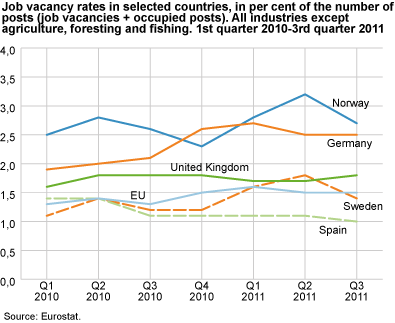Content
Published:
This is an archived release.
Growth in job vacancies
There were 62 200 job vacancies in the 4th quarter of 2011. This was up 6 400 compared to the same quarter of 2010. The major part of the growth took place in the private sector.
Comparing annual averages, the number of job vacancies increased by 7 300 from 2010 to 2011.
Most job vacancies in residential care activities
Residential care activities had the highest number of job vacancies in the 4th quarter of 2011, with 8 100. Then followed administrative and support service activities with 8 000 and domestic trade with 6 400. The industries with the highest number of employees generally have the highest number of job vacancies. However, in times when the economy is rising, an industry will tend to have more job vacancies.
Definitions:Vacant jobThe vacancy must be announced, formally or informally. Formal announcements include, for example, advertisements in newspapers, on the Internet, notifying the public employment services or private employment agencies. Informal announcements include, for example, advertisements in shop windows or public notice boards, or announcements via employees, friends or family. Job vacancies exclusively open to internal applicants (within the enterprise, organisation or corporation) are not included in this definition of job vacancies. The post must be paid. Rate of job vacancyThe number of job vacancies as a percentage of the number of employees + the number of job vacancies. |
Job vacancy rate up to 2.5
All major industries together had an increase in the job vacancy rate from 2.3 per cent in the 4th quarter of 2010 to 2.5 per cent in the 4th quarter of 2011. The job vacancy rate in administrative and support service activities was 5.7 per cent in the 4th quarter of 2011, 5.5 per cent in residential care activities, 4.6 per cent in professional, scientific and technical activities, and 3.8 per cent in mining and quarrying. In Norway, the latter is dominated by the oil and gas industry. Professional, scientific and technical activities and mining and quarrying had the largest increase in job vacancy rates - both with an increase of 1.1 percentage points from the 4th quarter of 2010 to the same quarter of 2011.
Norway among the European countries with the highest job vacancy rate
In the 3rd quarter of 2011, Norway had the second highest rate of job vacancies among the countries in the EU/EEA area, at 2.7 per cent. The comparison with other countries is based on the 3rd quarter of 2011, as the 4th quarter figures are not yet published.
Malta had the largest percentage of job vacancies in the 3rd quarter of 2011, with a rate of 2.9 per cent. Germany followed next after Norway, with a job vacancy rate of 2.5 per cent. The job vacancy rates of Sweden and Denmark were 1.4 and 1.3 per cent respectively. The EU countries combined had a job vacancy rate of 1.5 per cent in the 3rd quarter of 2011. Agriculture, forestry and fishing are excluded from this international comparison. For more information is available on Eurostat’s website .
Tables:
Contact
-
Arbeidsmarked og lønn
E-mail: arbeidsmarked@ssb.no
-
Rakel Gading
E-mail: rakel.gading@ssb.no
tel.: (+47) 40 81 14 75
-
Jan Sebastian Rothe
E-mail: jan.rothe@ssb.no
tel.: (+47) 91 31 99 06

